| List of Ranas of Mewar Sisodia House of Mewar | |
|---|---|
 | |
| Parent house | Guhila dynasty |
| Country | Kingdom of Mewar |
| Founded | 1326 |
| Founder | Hammir Singh |
| Current head | Mahendra Singh Mewar/Arvind Singh Mewar(head is disputed) |
| Final ruler | Bhagwant Singh of Mewar(titular) |
| Style(s) | Maharana, Rana |
| Cadet branches | |
The Sisodia clan of Mewar, also called the "House of Mewar", is a Rajput clan that ruled the Kingdom of Mewar, later called the Udaipur State under the British Raj.[1] The dynasty traces its ancestry back to Rahapa, a son of the Guhila king Ranasimha. Hammir Singh, a scion of this branch family of the Guhilas, re-established the Kingdom of Mewar after defeating the Tughluq sultans of Delhi.[2][3]
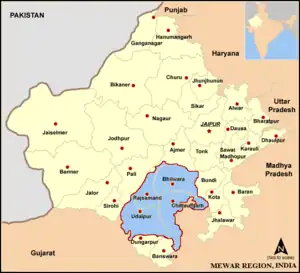
List of Maharanas
| Picture | Name of Maharana | Reign | Notes |
|---|---|---|---|
| Hammir Singh | 1326–1364 | He attacked Khiljis in 1326 and re-took Chittor from them which the family has lost to Khijis in 1303. Defeated Muhammad-bin-Tughluq in Singoli taking the sultan himself a prisoner of war.
Captured Ajmer, Ranthambor, Nagaur and Sopor.[4] | |
| Kshetra Singh | 1364–1382 | Hammir's son, He increased the Mewar control over Madalgarh and Bundi and completely annexed Ajmer.
He also defeated Amin Shah of Malwa at the Battle of Bakrole and inflicted heavy casualties. He passed away in 1405 after reasserting the control of Mewar on a very large area.[5] | |
| Lakha Singh | 1382–1421 | Khsetra's son, though he suffered multiple initial setbacks against Zafar Khan of Gujrat , he quickly regrouped and re established full control over all the territories.
He rebuilt temples and shrines which had been destroyed by Allaudin khilji.[6] | |
 |
Mokal Singh | 1421-1433 | Lakha's son, He defeated the sultan of Nagaur , Gujrat. Later the sultan of Gujrat invaded Mewar and during this invasion, he was assassinated allegedly by his uncles Chacha and Mera.[7] |
 |
Rana Kumbha | 1433–1468 | Mokal's son, his first important achievement was attacking and killing his father's assassins.His further accomplishments included absolute defeat of the Sultans of Nagaur, Gujarat and Malwa. Inder his able leadership,
Mewar became the strongest kingdom in North India. He built multiple strong forts in Mewar.[8] |
| Udai Singh I | 1468–1473 | Kumbha' son, he is infamous for having assassinated his own father , however his treachery did not last long and in just 5 years he was defeated by his brother.[9] | |
| Rana Raimal | 1473–1508 | Son of Kumbha, following the moral of the BhagvadGeeta he re-established Dharm - righteousness and showed that every adharmi - non righteous person - even if he was a brother deserved the strictest of punishments. He defeated and killed his brother who had assassinated one of the most noble of Ranas - Rana Kumbha. He retained control over Mewar despite many attempts by the sultan of Malwa.[10][11] | |
 |
Rana Sanga | 1508–1527 | Raimal's son, true to his name Rana Sangram Singh - shortened to Rana Sanga carried forth his father's legacy and once again summarily defeating the Sultan of Gujrat, Malwa and Delhi.
Under his rule Mewar reached its pinnacle in power and prosperity. After a long term of over 25 years, he was accidentally struck in the eye during Babur's invasion and eventually lost when his army thought he had been killed. Babur[12][13] |
| Ratan Singh II | 1528–1531 | Sanga's son, Defeated and killed by Bahadur Shah of Gujarat.[14] | |
| Vikramaditya Singh | 1531–1536 | Sanga's son, Assassinated by his cousin Vanvir Singh.[15] | |
| Vanvir Singh | 1536–1540 | Usurper of the throne. Defeated and expelled by his cousin Udai Singh II.[16] | |
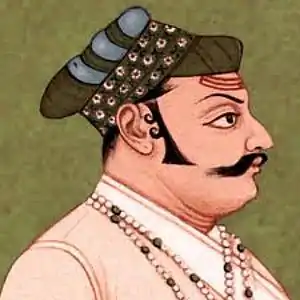 |
Udai Singh II | 1540–1572 | Sanga's son, Defeated Vanvir. Fought against Mughals and was defeated in Siege of Chittorgarh.[17][18] |
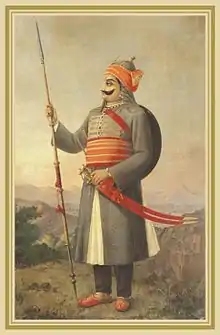 |
Maharana Pratap | 1572–1597 | Udai's son, Notable for his military resistance against the Mughals.[19] |
 |
Amar Singh I | 1597–1620 | Pratap's son, Notable for his struggle against Mughals and eventual treaty with the Mughals in 1615.[20] |
 |
Karan Singh II | 1620–1628 | Amar's son, Maintained good relations with Mughals, Built Temples, forts and strengthened existing ones.[21] |
 |
Jagat Singh I | 1628–1652 | Karan's son, Attempted to restore fort of Chittor but Shah Jahan blocked his attempt. |
.jpg.webp) |
Raj Singh I | 1652–1680 | Jagat's son, Fought against Mughals many times. Regained territory and increased the wealth of the kingdom.
Fought against Aurangzeb. Eventually poisoned by Aurangzeb's loyalists.[22][23][24] |
 |
Jai Singh | 1680–1698 | Raj's son, Struggled to regain captured parts of Mewar from Mughals.[25] |
 |
Amar Singh II | 1698–1710 | Jai's son, Invaded neighboring territories, Formed an alliance against the Mughals with Jaipur and Marwar.
Capitalized over a weak Mughal empire.[26] |
 |
Sangram Singh II | 1710–1734 | Amar's son, Defeated Ranabaaz khan at the Battle of Bandanwara.
Reestablished relations with a weak Mughal Emperor. |
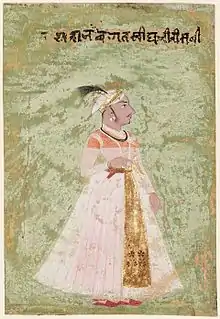 |
Jagat Singh II | 1734–1751 | Sangram's son, started paying chauth to the Marathas.
Heavily invested in placing Sawai Madho Singh on the throne of Jaipur, eventually bankrupting Mewar. |
 |
Pratap Singh II | 1751–1754 | |
 |
Raj Singh II | 1754–1762 | Pratap's son, Paid heavy tribute to Maratha's, financially devastating Mewar. |
 |
Ari Singh II | 1762–1772 | Raj's son, Under him, Maratha's raided Mewar multiple times for not paying tribute. |
| Hamir Singh II | 1772–1778 | Ari's son, Underaged when became Rana and died. | |
 |
Bhim Singh | 1778–1828 | Hamir's brother, Under him, Mewar was repeatedly raided by Pindaris, Marwar and Jaipur fought for his daughter Krishna Kumari.
Accepted sub ordinance of East India Company. |
 |
Jawan Singh | 1828–1838 | Bhim's son, Abused alcohol, not interested in ruling Mewar. Mewar racked up a lot of debt under his rule. |
| Sardar Singh | 1838–1842 | ||
._Udaipur%252C_1851%252C_City_Palace_Museum%252C_Udaipur._(cropped).jpg.webp) |
Swarup Singh | 1842-1861 | Ruler during the Indian Rebellion of 1857. |
 |
Shambhu Singh | 1861–1874 | Focused on reform of education and social reform |
 |
Sajjan Singh | 1874–1884 | |
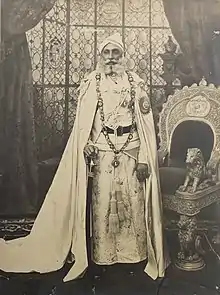 |
Fateh Singh | 1884–1930 | |
 |
Bhupal Singh | 1930–1948 | Signed the Instrument of Accession to India, dissolving his kingdom into the Dominion of India. |
| Titular Maharanas | |||
| Bhupal Singh | 1948–1955 | ||
 |
Bhagwat Singh | 1955–1984 | Lost the Privy Purse in 1971, and was derecognised under the 26th Amendment of the Constitution of India. |
 |
Mahendra Singh (titular monarch without official recognition) | 1984–present | |
See also
References
- ↑ Manoshi, Bhattacharya (2008). The Royal Rajputs. Rupa & Company. pp. 42–46. ISBN 9788129114013.
- ↑ Rima Hooja (2006). A history of Rajasthan. Rupa. pp. 328–329. ISBN 9788129108906. OCLC 80362053.
- ↑ The Rajputs of Rajputana: a glimpse of medieval Rajasthan by M. S. Naravane ISBN 81-7648-118-1
- ↑ Ram Vallabh Somani 1976, pp. 105–107.
- ↑ Ram Vallabh Somani 1976, pp. 109–111.
- ↑ Ram Vallabh Somani 1976, pp. 112–113.
- ↑ Ram Vallabh Somani 1976, pp. 117–119.
- ↑ Ram Vallabh Somani 1976, pp. 122–144.
- ↑ Ram Vallabh Somani 1976, pp. 146–147.
- ↑ Ram Vallabh Somani 1976, pp. 146–148.
- ↑ Ram Vallabh Somani 1976, pp. 151–153.
- ↑ Ram Vallabh Somani 1976, pp. 152–169.
- ↑ "Maharana Sanga; the Hindupat, the last great leader of the Rajput race: Sarda, Har Bilas, Diwan Bahadur, 1867–1955 : Free Download, Borrow, and Streaming". Internet Archive. Retrieved 16 August 2020.
- ↑ Ram Vallabh Somani 1976, pp. 171–181.
- ↑ Ram Vallabh Somani 1976, pp. 189.
- ↑ Ram Vallabh Somani 1976, pp. 189–193.
- ↑ Ram Vallabh Somani 1976, pp. 193.
- ↑ Ram Vallabh Somani 1976, pp. 208–215.
- ↑ Ram Vallabh Somani 1976, pp. 220–230.
- ↑ Ram Vallabh Somani 1976, pp. 253–259.
- ↑ Ram Vallabh Somani 1976, pp. 260.
- ↑ Sharma, Gopinath. Rajasthan Ka Itihas. Agra. p. 278. ISBN 978-81-930093-9-0.
- ↑ Hooja, Rima (1 November 2006). A history of Rajasthan. Rupa & Co. p. 617. ISBN 9788129108906.
- ↑ Ram Vallabh Somani 1976, pp. 281–282.
- ↑ Sen, Sailendra (2013). A Textbook of Medieval Indian History. Primus Books. p. 183. ISBN 978-9-38060-734-4.
- ↑ Ram Vallabh Somani 1976, pp. 315.
Bibliography
- Ram Vallabh Somani (1976). History of Mewar, from Earliest Times to 1751 A.D. Mateshwari. OCLC 2929852.